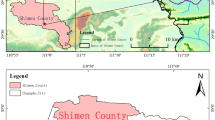Abstract
Arsenic release from the abandoned mines and its fate in a local stream were studied. Physicochemical parameters, metals/metalloids and arsenic species were determined. One of the mine drainages was found as a point source of contamination with 309 μg L−1 of dissolved arsenic; this concentration declined rapidly to 10.5 μg L−1 about 2 km downstream. Data analysis confirmed that oxidation of As(III) released from the primary sulfide minerals was favored by the increase of pH and oxidation reduction potential; the results obtained in multivariate approach indicated that self-purification of water was due to association of As(V) with secondary solid phase containing Fe, Mn, Ca.

Similar content being viewed by others
References
Asta MP, Ayora C, Acero P, Cama J (2010) Field rates for natural attenuation of arsenic in Tinto Santa Rosa acid mine drainage (SW Spain). J Hazard Mater 177:1102–1111
Bundschuh J et al (2010) Emerging mitigation needs and sustainable options for solving the arsenic problems of rural and isolated urban areas in Latin America—a critical analysis. Water Res 44:5828–5845
de Pablo Galan L, Chavez Garcia M (1996) Diagenesis of digocene vitric tuffs to zeolites Mexican volcanic belt. Clay Clay Miner 44:324–338
Kannamkumarath SS, Wrobel K, Wrobel K, Caruso JA (2004) Speciation of arsenic in different types of nuts by ion chromatography–inductively coupled plasma mass spectrometry. J Agric Food Chem 52:1458–1463
Landero Figueroa JA, Wrobel K, Afton S, Caruso JA, Gutiérrez-Corona JF, Wrobel K (2008) Effect of some heavy metals and soil humic substances on the phytochelatin production in wild plants from silver mine areas of Guanajuato, Mexico. Chemosphere 70:2084–2091
Lopez DL et al (2012) Arsenic in volcanic geothermal fluids of Latin America. Sci Tot Environ 429:57–75
Morton-Bermea O, Carrillo-Chavez A, Hernandez E, Gonzalez-Partida E (2004) Determination of metals for leaching experiments of mine tailings: evaluation of potential environmental hazard in the Guanajuato mining district, Mexico. Bull Environ Contam Toxicol 73:770–776
NOM-127-SSA1-1994 NOM (1994), Salud Ambiental, agua para uso y consumo humano - limites permisibles de calidad y tratamientos a que debe someterse el agua para su potabilización
Peltier E, Dahl AL, Gaillard JF (2005) Metal speciation in anoxic sediments: when sulfides can be construed as oxides. Environ Sci Technol 39:311–316
Ramos Arroyo YR, Siebe C (2007) Wheathering of sulphide minerals and trace element speciation in tailings of various ages in the Guanajuato mining district. Mexico Catena 71:497
Randall Roberts JA, Saldaña E, Clark KF (1994) Exploration in a volcano-plutonic center at Guanajuato, Mexico. Econom Geol 89:1722–1751
Rodriguez Flores C, Landero Figueroa JA, Wrobel K (2009) ICP-MS multi-element profiles and HPLC determination of furanic compounds in commercial tequila. Eur Food Res Technol 228:951–958
Romero FM, Nuñez L, Gutierrez ME, Armienta MA, Cenciceros-Gomez AE (2011) Evaluation of the potential of indigenous calcaeous shale for neutralization and removal of arsenic and heavy metals from acid mine drainage in the Taxco mining area, Mexico. Arch Environ Contam Toxicol 60:191–203
Simpson S, Sherriff BL, Van Gulk J, Khozhina E, Londry K, Sidenko N (2011) Source, attenuation and potential mobility of arsenic at New Britannia Mine, Snow Lake, manitoba. Appl Geochem 26:1843–1854
Smedley PL, Kinniburgh DG (2002) A review of the source, behaviour and distribution of arsenic in natural waters. Appl Geochem 17:517–568
Tokoro C, Yatsugi Y, Koga H, Owada S (2010) Sorption mechanisms of arsenate during coprecipitation with ferrihydrite in aqueous solution. Environ Sci Technol 44:638–643
Wold S, Esbensen K, Geladi P (1987) Principal components analysis. Chemometr Intell Lab Syst 2:37–52
Acknowledgments
The financial support from National Council of Science and Technology, Mexico (CONACYT), Project 178553, is gratefully acknowledged.
Author information
Authors and Affiliations
Corresponding author
Electronic supplementary material
Below is the link to the electronic supplementary material.
Rights and permissions
About this article
Cite this article
Arroyo, Y.R.R., Muñoz, A.H.S., Barrientos, E.Y. et al. Natural Decrease of Dissolved Arsenic in a Small Stream Receiving Drainages of Abandoned Silver Mines in Guanajuato, Mexico. Bull Environ Contam Toxicol 91, 539–544 (2013). https://doi.org/10.1007/s00128-013-1091-7
Received:
Accepted:
Published:
Issue Date:
DOI: https://doi.org/10.1007/s00128-013-1091-7




